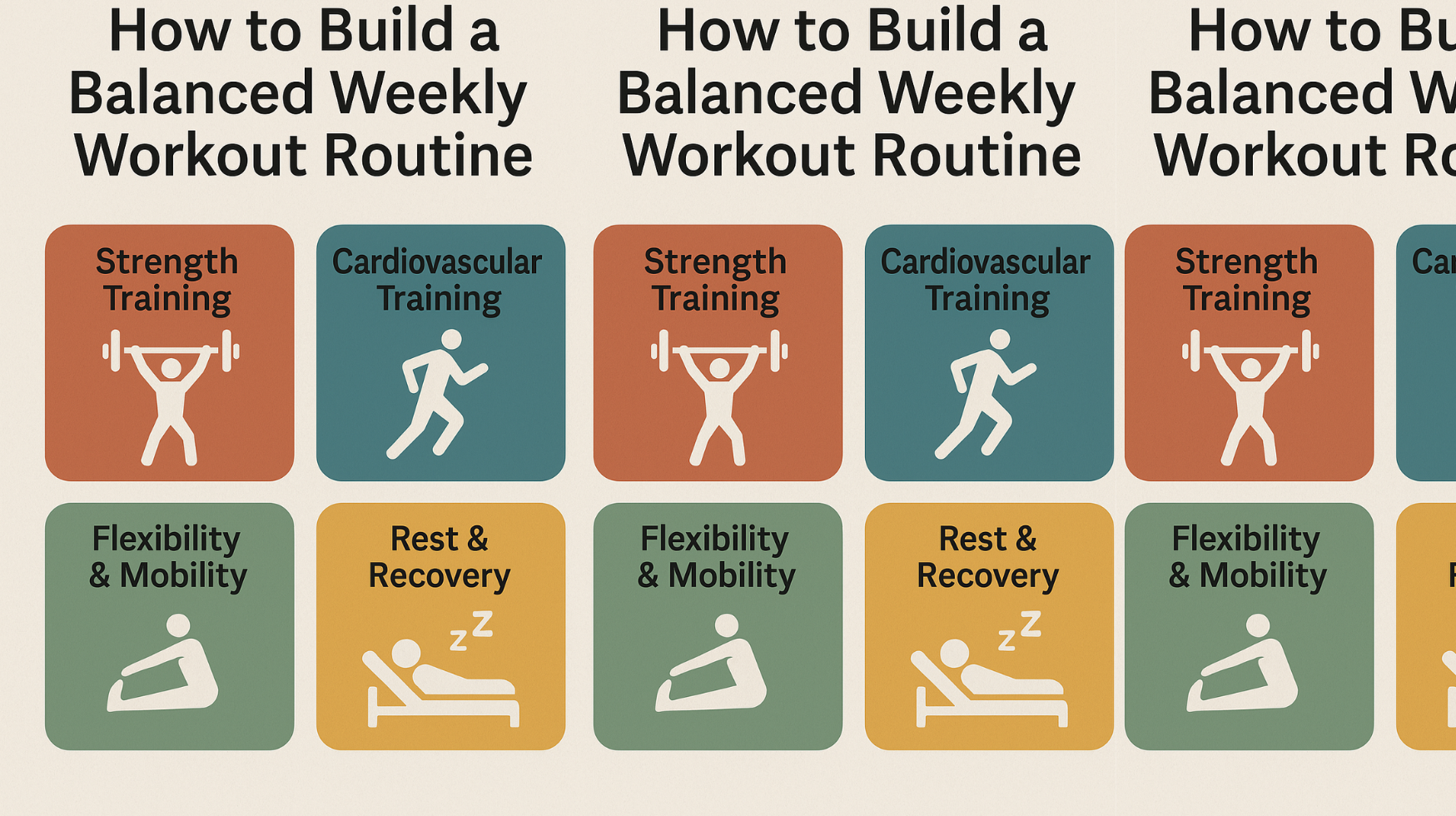Introduction: Why Balance is the Secret to Sustainable Fitness
Many people approach fitness with the “go hard or go home” mentality—spending every day on intense cardio, lifting heavy weights without recovery, or sticking to one type of workout they enjoy. While enthusiasm is great, a lack of balance often leads to burnout, injury, or plateaus.
A balanced workout routine doesn’t mean you do a little bit of everything randomly. Instead, it means structuring your week so your body develops strength, endurance, flexibility, and recovery in harmony. This ensures your muscles and joints stay healthy, your energy levels remain steady, and your results keep improving over time.
In this comprehensive guide, you’ll learn:
- Why balanced training matters for your body and mind
- The four pillars every routine should include
- How to build a personalized 7-day workout schedule
- Practical tips to stay consistent and injury-free
The Four Pillars of a Balanced Workout
A truly effective workout plan includes these components:
1. Strength Training
- Builds and preserves muscle mass
- Increases metabolism (even at rest)
- Improves bone density and joint stability
2. Cardiovascular Training
- Strengthens your heart and lungs
- Improves circulation and endurance
- Helps burn calories and manage weight
3. Flexibility & Mobility
- Prevents stiffness and injuries
- Improves posture and range of motion
- Enhances movement efficiency
4. Rest & Recovery
- Allows muscle repair and growth
- Prevents overtraining
- Restores mental and physical energy
Why Balance Matters for Long-Term Results
Reduces Injury Risk
Overuse injuries are common when one type of training dominates your routine. By alternating workout types, you give certain muscles and joints time to recover while training others.
Improves Overall Fitness
Strength alone won’t give you great endurance. Cardio without strength can lead to muscle loss. Flexibility without stability can cause weakness. Combining all aspects makes you a well-rounded athlete.
Keeps Motivation High
Variety keeps things interesting. A routine that mixes different training types is more enjoyable and sustainable.
Step 1: Define Your Fitness Goals
Your ideal weekly plan depends on your primary objective:
- Fat Loss → Strength + Cardio balance with a slight calorie deficit
- Muscle Gain → More emphasis on strength, with light cardio for heart health
- Endurance → Cardio-focused, but maintain strength to prevent imbalances
- General Health → Equal mix of all four pillars
Step 2: Plan Your Weekly Structure
A well-balanced beginner-to-intermediate plan might look like this:
Monday – Strength Training (Full Body)
Tuesday – Cardio (Moderate Intensity)
Wednesday – Mobility & Flexibility + Light Activity
Thursday – Strength Training (Upper Body Focus)
Friday – Cardio Intervals or HIIT
Saturday – Strength Training (Lower Body Focus)
Sunday – Rest or Gentle Yoga
Step 3: Strength Training in Your Routine
Frequency: 2–4 sessions/week
Key Movements:
- Lower Body: Squats, lunges, deadlifts
- Upper Body: Push-ups, rows, bench press
- Core: Planks, bird dogs, side planks
Guidelines:
- Beginners: 2–3 sets of 10–12 reps
- Intermediate: 3–4 sets of 6–10 reps
- Rest 60–90 seconds between sets
Tip: Focus on compound exercises (multi-joint movements) for maximum efficiency.
Step 4: Cardiovascular Training for Heart and Lungs
Frequency: 2–3 sessions/week
Options:
- Steady-State (jogging, cycling, swimming)
- Interval Training (alternating high and low intensity)
Duration:
- Beginners: 20–30 min
- Intermediate: 30–45 min
Sample HIIT Workout:
- 30 seconds sprint / 90 seconds walk — repeat 6–8 times
Step 5: Flexibility and Mobility for Pain-Free Movement
Frequency: At least 2 sessions/week
Focus Areas:
- Dynamic stretches before workouts
- Static stretches after workouts
- Mobility drills for hips, shoulders, spine
Examples:
- Cat-Cow stretch
- Hip openers
- Shoulder pass-throughs with resistance band
Step 6: Rest and Recovery Days
Rest days aren’t “lost” days—they’re when the body actually adapts to training.
Active Recovery Ideas:
- Gentle yoga
- Walking outdoors
- Light swimming
- Foam rolling
Sleep Tip: Aim for 7–9 hours nightly for optimal recovery.
Step 7: Sample Weekly Balanced Plan (General Fitness)
| Day | Workout Type | Example |
|---|---|---|
| Monday | Strength (Full Body) | Squats, push-ups, rows, planks |
| Tuesday | Cardio | 30 min cycling |
| Wednesday | Flexibility/Mobility | 30 min yoga |
| Thursday | Strength (Upper) | Bench press, rows, overhead press |
| Friday | Cardio HIIT | 20 min intervals |
| Saturday | Strength (Lower) | Deadlifts, lunges, glute bridges |
| Sunday | Rest | Walking or gentle stretching |

